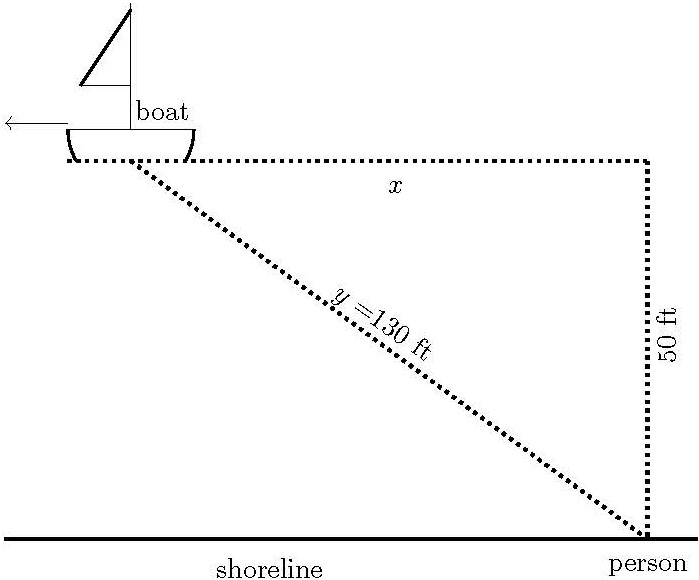We let \(x\) denote the position of the ball (as a distance from home plate) at time \(t\) and \(z\) the distance from the ball to first base, as pictured below.
By the Pythagorean Theorem, we know that \(x^2 + 90^2 = z^2\text{;}\) differentiating with respect to \(t\text{,}\) we have
\begin{equation*}
2x\frac{dx}{dt} = 2z\frac{dz}{dt}\text{.}
\end{equation*}
At the instant the ball is halfway to third base, we know \(x = 45\) and \(\left. \frac{dx}{dt} \right|_{x = 45} = 100\text{.}\) Moreover, by the Pythagorean Theorem, \(z^2 = 90^2 + 45^2\text{,}\) so \(z = 45\sqrt{5}\text{.}\) We can solve for \(\frac{dz}{dt} \) using the equation above and then plug in all of the known variables:
\begin{align*}
\left.\frac{dz}{dt}\right|_{x=45}=\mathstrut\amp\left.\left(\frac xz\frac{dx}{dt}\right)\right|_{x=45}\\
=\mathstrut\amp\frac{45}{45\sqrt5}(100)\\
\approx\mathstrut\amp44.7214 \ \text{ft/sec}\text{.}
\end{align*}
Therefore, the distance between the ball and first base is at this instant growing at a rate of about \(44.72\) feet per second.
For the second question, we still let \(x\) represent the ball's position at time \(t\text{,}\) but now we introduce \(r\) as the runner's position (also as a distance from home plate) at time \(t\) and let \(s\) be the distance between the runner and the ball. In this setting, as seen in the diagram below, \(x\text{,}\) \(r\text{,}\) and \(s\) form the sides of a right triangle, so that
\begin{equation}
x^2 + r^2 = s^2\text{,}\label{baseballPT}\tag{4.3}
\end{equation}
by the Pythagorean Theorem.
Differentiating each side of Equation(4.3) with respect to \(t\text{,}\) it follows that the three rates of change are related by the equation
\begin{equation*}
2x \frac{dx}{dt} + 2r \frac{dr}{dt} = 2s \frac{ds}{dt}\text{.}
\end{equation*}
We are given that at the instant \(x = 45\text{,}\) \(r = \frac{90}{8}=\frac{45}4\text{,}\) so solving for \(s \) in the equation above, we have \(s = \frac{45}{4}\sqrt{17}\text{.}\) In addition, at this same instant we know that \(\left. \frac{dx}{dt} \right|_{x = 45} = 100\) and \(\left. \frac{dr}{dt} \right|_{x = 45} = 30\text{.}\) Solving for \(\frac{ds}{dt} \) and applying this information, we end up with
\begin{align*}
\left.\frac{ds}{dt}\right|_{x=45}=\mathstrut\amp\left.\left(\frac xs\frac{dx}{dt}+\frac rs\frac{dr}{dt}\right)\right|_{x=45}\\
=\mathstrut\amp\frac{45}{\big(\frac{45}4\sqrt{17}\big)}(100)+\frac{\big(\frac{45}4\big)}{\big(\frac{45}4\sqrt{17}\big)}(30)\\
=\mathstrut\amp\frac{400}{\sqrt{17}}+\frac{30}{\sqrt{17}}\\
=\mathstrut\amp\frac{430}{\sqrt{17}}\\
\approx\mathstrut\amp104.2903 \ \text{ft/sec}\text{.}
\end{align*}
Therefore, the distance between the ball and the runner is at this instant increasing at a rate of about \(104.29\) feet per second.

